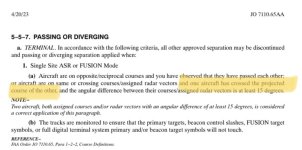Sassyquatch
Trusted Contributor
- Messages
- 242
The rule states
" TERMINAL. In accordance with the following criteria, all other approved separation may be discontinued and passing or diverging separation applied when:
a.)...aircraft are on same or crossing courses/assigned radar vectors and one aircraft has crossed the projected course of the other, and the angular difference between their courses/assigned radar vectors is at least 15 degrees.
NOTE-
Two aircraft, both assigned courses and/or radar vectors with an angular difference of at least 15 degrees, is considered a correct application of this paragraph.
b) The tracks are monitored to ensure that the primary targets, beacon control slashes, FUSION target symbols, or full digital terminal system primary and/or beacon target symbols will not touch."
The key issue is "assigned radar vectors". Management is saying aircraft must be established on 15° or more before you apply passing and diverging, but it does not read that way. It reads if you assign a vector that ensures 15° and apply subparagraph b, then you can use passing and diverging prior to the aircraft turning 15° or more.
This is a specific application where I work due to a departure course and arrival course to a satellite airport diverging by 8°. Specifically if an aircraft goes around at the main airport and you have someone on final to the satellite airport.
Management refuses to submit an interpretation request, I've asked at least twice already. Their reasoning is it takes too long to get an answer back. We've been arguing this rule since February. They have email correspondence with a QA/QC person who was once a supervisor here. I've been told it was an "unofficially official interpretation to the rule". Their exact words. The email said the same thing I was told, stating "[QA/QC] opinion is that both aircraft must be established on the headings diverging by 15° or more".
" TERMINAL. In accordance with the following criteria, all other approved separation may be discontinued and passing or diverging separation applied when:
a.)...aircraft are on same or crossing courses/assigned radar vectors and one aircraft has crossed the projected course of the other, and the angular difference between their courses/assigned radar vectors is at least 15 degrees.
NOTE-
Two aircraft, both assigned courses and/or radar vectors with an angular difference of at least 15 degrees, is considered a correct application of this paragraph.
b) The tracks are monitored to ensure that the primary targets, beacon control slashes, FUSION target symbols, or full digital terminal system primary and/or beacon target symbols will not touch."
The key issue is "assigned radar vectors". Management is saying aircraft must be established on 15° or more before you apply passing and diverging, but it does not read that way. It reads if you assign a vector that ensures 15° and apply subparagraph b, then you can use passing and diverging prior to the aircraft turning 15° or more.
This is a specific application where I work due to a departure course and arrival course to a satellite airport diverging by 8°. Specifically if an aircraft goes around at the main airport and you have someone on final to the satellite airport.
Management refuses to submit an interpretation request, I've asked at least twice already. Their reasoning is it takes too long to get an answer back. We've been arguing this rule since February. They have email correspondence with a QA/QC person who was once a supervisor here. I've been told it was an "unofficially official interpretation to the rule". Their exact words. The email said the same thing I was told, stating "[QA/QC] opinion is that both aircraft must be established on the headings diverging by 15° or more".
